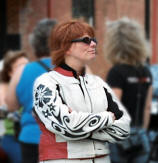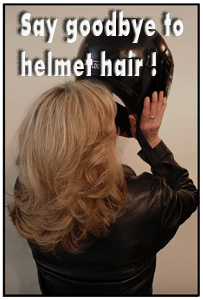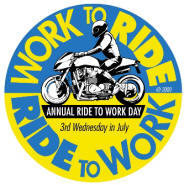HH: You’ve reignited the USA chapter of
the Women’s International Motorcycle
Association, better known as WIMA. What
happened to the former chapter and what
inspired you to take on such a tremendous
task?
Alice: Louise
Scherbyn founded WIMA in 1950 or so, after
she had been instrumental in forming the
Motor Maids and wanted something more.
Apparently she was very charismatic and
remained president of WIMA until her death
in 1999. As she aged and became less
active, WIMA in the USA became less active
accordingly. Once she entered a nursing
home, no one wished to take away her title
of president, and WIMA in the USA slowly
vanished. Meanwhile - WIMA, in Great
Britain, Australia and Europe, was
becoming the largest organization of women
riders in the world, thus forming
‘chapters’ by country.
In 1996
Sheonagh Ravensdale of WIMA GB convinced
other members of WIMA Europe that a new
president was necessary. She was elected
to be the second president of WIMA and
held that post until she stepped down in
2003. I met Sheonagh at the 2002 AMA Women
and Motorcycling Conference where she was
actively recruiting someone to revive WIMA
in the USA. I was not interested, as I
have never been a joiner, or one to
participate in group riding.
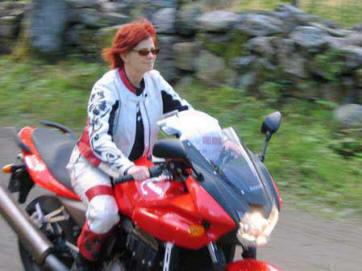
|
Alice
in parade at the 2006 AMA
International Women and Motorcycling
Conference in Athens, GA. |
Once I got
home, I began to wonder if there were
other women riders, who like me, didn’t
want to ‘join’ a women’s ‘club’, but still
wanted to see more opportunities for women
in the sport of motorcycling. After doing
some research I found Louise Sherbyn’s
original mission, which was basically to
connect women motorcycle racers,
travelers, adventurers and enthusiasts and
to help them in their endeavors. She
actually lobbied the FIM to allow women to
compete against the men.
I also
realized, and saw first hand, how the
passing of Title Nine when I was in
college made a tremendous difference by
bringing [financial] equality to women in
sports. If I could help other women
motorcyclists realize their dreams, and
help the industry recognize women riders,
then it might just be worth it. I sent
Sheonagh my resume, and although there
were many applicants, I got the nod. Mind
you- this is all volunteer- there is no
salary— as a matter of fact I spent a load
of my own bank to get things off the
ground.
As for
inspiration, the first thing I did was
contact a woman I had met years earlier,
even though we had not been in touch for
quite some time, and ask her to join me as
Vice President. Amazingly- the same day I
made the call, Erica B. Smith’s WIMA
membership arrived in the mail. What we
have accomplished to date would not be
possible without Erica!
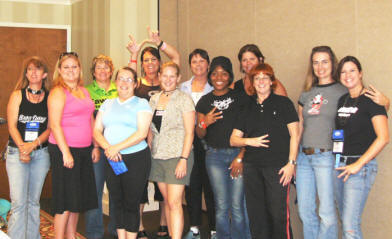
|
WIMA
USA's first meeting with Alice at
the helm during the 2006 AMA
International Women and Motorcycling
Conference. Notice our "gang"
sign... |
HH:
What’s the health of WIMA USA today, and
what’s in store for its members in the
future?
Alice:
Ah yes. It’s been a bit of a struggle
because our goals and mission are not
easily recognizable as tangible items and
we don’t follow the normal format of other
women’s organizations. Although WIMA
certainly welcomes all- and we do mean
ALL- women riders and passengers, and
anyone who joins is accepted, not every
woman motorcyclist is cut out to be a
WIMA. A WIMA member is someone who enjoys
and appreciates all aspects of
motorcycling, not just one facet. She is
adventurous, curious, and pro-active,
promotes a positive self-image, and
believes women should be equally
represented in the industry. A WIMA member
is also not afraid to embrace different
cultures, attitudes, customs or styles.
We
currently have just over 100 members in
WIMA USA, and the total for WIMA World is
over 3,000. What’s in store for the future
of WIMA USA? As we grow and are guided by
our vision and mission statements, I hope
the active participation of our members,
the organization itself, will form our
future. In the short term, we have just
been given 501(c) 3 non-profit status, so
all membership fees and donations are now
tax-deductible contributions.
We are
also in the process of designing a new
logo and recreating our web site to become
a valuable interactive resource for all
women riders. We are working on expanding
our member newsletter and are working
toward regular publication. These many
efforts take quite a bit of time,
especially when we’re all volunteers with
careers, families, businesses and of
course some riding time thrown in!
HH:
As WIMA USA continues to grow, do you see
a specific demographic trend in membership
(in respect to member’s average age,
locale and type of bikes ridden)?
Alice:
We’re all over the map
there, and that’s our goal! As I said
above, the woman who joins WIMA is
interested in all aspects of motorcycling.
Most of our members own more than one
bike, and those bikes are often across all
disciplines. Many members own a dirt bike,
a sport bike AND a cruiser! The most
common answer I get on the membership
application when asked what areas of
motorcycling interests you is: ALL! These
women are WIMA!
We do see most accumulation of members on
both coasts, and less members in the
mid-US, but that follows basic population
numbers.
As for average age, we don’t ask for that
information on our application. We are all
as young as we feel.
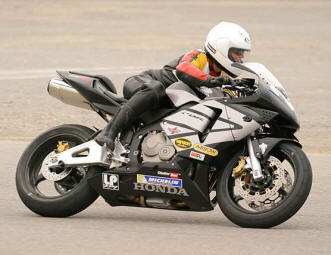
|
On a Honda CBR600 at
Freddie Spencer's High Performance
Riding School, 2005. |
HH: You’ve held a handful of professional
jobs in the motorcycle industry, with your
last as a brand promotions director at
Advanstar, a leading provider of
integrated media solutions to the
powersports, off-road and automotive
aftermarket industry. Do you have any
words of wisdom to share with other women
who are interested in professional careers
in the field? What should they really
expect?
Alice: Don’t expect everyone in the
industry to be an enthusiast! I found this
out the hard way. Many companies are
now hiring non-enthusiasts specifically to
go after new markets/non-riders and seem
to be placing less value on the experience
of riders and their knowledge of the
market, instead getting their information
from marketing surveys (also designed by
non-enthusiasts). The bottom line takes
precedent over everything. Don’t expect a
casual environment, the motorcycle
industry is very corporate.
Most of the executives are not
motorcyclists, and this did surprise me.
I’ve even had one Executive VP tell me
they didn’t want to hire enthusiasts; they
wanted to hire ‘real’ marketing people.
Does that mean someone with an MBA who
rides a motorcycle is less qualified than
one who doesn’t? Hmmmm.
Do expect that a man will be hired over a
woman. Do expect to be paid a much lower
salary than other industries. Do expect to
work your butt off.
As for advice to women who want to break
into the field, network, network, network.
The powersports industry is a small group
and it helps if you get involved and
promote yourself. Whenever I hear of a
good job opportunity, I pass the info on
to our WIMA members. Women won’t get these
jobs if they never apply for them!
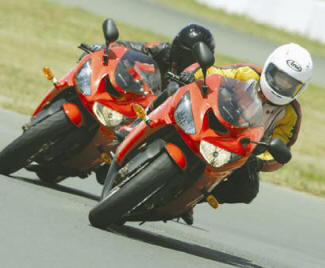
|
Test riding a
Kawasaki 636 at Infineon 'Women in
the Media' press event, 2005. |
HH: It’s no secret that you love to ride
fast – you actually received a National
Championship Cup license at the tender age
of 40. And today you regularly participate
in track days and vintage lightweight
races, providing an inspiration to many of
us whom are either closely approaching or
those of us who are already enjoying
middle age. What keeps you fearless?
Alice:
Fearless- that’s quite funny. Each time I
go out on the track the first lap still
scares the crap out of me, and everyone I
know says the same thing- men and women
alike.
I don’t
really do track days any more, I find the
riders to be erratic and aggressive with
too many street rider’s bad habits and
full of ego too boot, not a good combo.
Now I race with Willow Springs Motorcycle
Club once a month and since every year
racers die at that track, there’s plenty
of fear to go around. Even though I’m far
from the fastest on the track, I hold my
lines and take a steady approach. I’m
picking away at the seconds, taking small
goals as big victories and slowly (very
slowly-ack!) decreasing my lap times. As
my racer friend Patricia in Norway says,
“Yeees, I am een NOoo dahngers ov
weeeenning eh raace”!
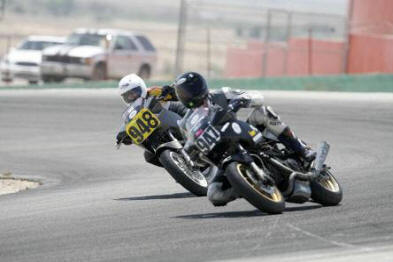
|
Alice's husband, Ed, passes her in
turn four. |
I have
always liked the camaraderie that comes
with competition. My father raced boats
and I was pit crew starting at age 12, it
was a family effort. Another road racer
friend describes club racing like a family
BBQ where you go out and risk your life
for about 20 minutes. There’s definitely a
bond, even if you’re not finishing in the
top 3, or 10, or uh- you’re getting lapped
by your husband.
So I guess
the answer as to what keeps me fearless is
fear. Taking calculated risk keeps my
blood pumping. Getting a good start and
being in the middle of the pack heading
into turn one is actually starting to be
fun. Having a much faster rider pass
within inches of me on the track is
frightening yet beautiful all at the same
time.
HH: And finally, here’s your chance to
pitch to those female riders who have
resisted the opportunity to join a
motorcycle club or association. Why should
they join?
Alice:
I’m not one to make a sales pitch.
Either you believe in what we’re trying to
do or you don’t. As the number of women
riders increases, the industry needs to
reflect those numbers in their hiring. Our
tag line: Changing the Face of
Motorcycling means exactly that. We’d like
to see women represented in higher
positions in the AMA and the Hall of Fame.
We believe that if more women were hired
to design and market apparel/gear there
would be better choices for women riders.
We believe that if more women held
decision making positions in the industry
we’d see fewer advertisements or products
with graphics that are demeaning to women.
There is power in numbers and WIMA aims to
be the voice for all women riders.
WIMA is
truly an amazing International
organization. Recently Linda Booth turned
60 during her 6 months solo ride from
Germany to Australia. Sheonagh Ravensdale
and Pat Thomson rode from the tip of South
America to Atlanta, GA. Trui and Gaea are
just now undertaking a 6 months trip from
Belgium to Central Asia and back. Rhiannon
Lucente missed qualifying for the Daytona
200 by 4 tenths of a second. Marisol
‘Isis’ Coachman was named ‘Fastest Woman
in Georgia’ for her drag racing efforts.
Julee Cope is riding solo from Ohio to Las
Vegas on her dual-sport for a business
conference and then plans to “head west
and look for some good roads” she says.
Helen Horn is leaving from Los Angeles on
her Harley for a solo ride around the US
with stops in New Orleans, Atlanta,
Washington DC, New York Chicago and all
points west. These are the women of WIMA,
and I am proud to be a member.
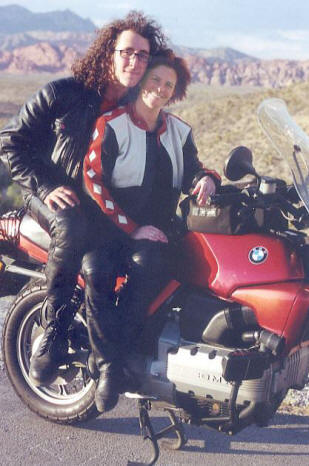
|
2000 Wedding:
Ed and
Alice on the K-bike, Redrock Canyon,
NV, a few miles outside of Vegas.
Photographed by Pat Lanza.
|
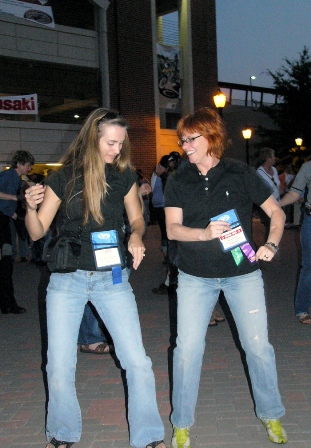
|
Shake your money maker: Helmet
Hair editor, Cara Mae, and Alice
dancing at the after party during
the 2006 AMA International Women and
Motorcycling Conference. |

 Diane Howells
Motorcycle safety schools
Diane Howells
Motorcycle safety schools Jennifer
Caputo
legendary stuntwoman & motocross rider
Jennifer
Caputo
legendary stuntwoman & motocross rider Paula
Johnson
Riding for Africa
Paula
Johnson
Riding for Africa
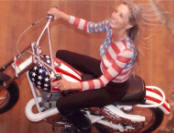 Alicia
Karstens
GoMoto
Alicia
Karstens
GoMoto
 Cast of MotoFemina
Cast of MotoFemina

